
North Cascades River Expeditions
| Home | 10 River Trips | Schedule | FAQ | Prices | Upcoming
Trips |
| How to Dress | Related Webs | Guide Training | Responsibility |
| Entry | Picket Fence | House Rock | Ledge Wave | Long Swim |

The Picket Fence constitutes a Class IV barrier that all rafts need to negotiate. Three plausible routes exist. From river left to river right:
Airplane TurnLocated river left, rafters prefer Airplane Turn at levels between 1500cfs (minimum runnable level) and 3800 cfs. Above 5000 cfs, the turn becomes too difficult to access. Even if you make the turn at high water, the airplane motion that gives the drop its name sets the stage for a bad visit with House Rock, some 40 yards downstream. Because the river is running at 7500 cfs in this photo, there is almost no chance a raft could make this route on this day. |
 |
 |
Needle DropRafters prefer Needle Drop at levels between 3800 cfs and 8000 cfs. At levels above 8000 cfs, the Needle tends to make a dangerous weir. The drop here is around 6 feet but it always seems like 10. Rafts can (and have) flipped here, but the drop is a lot easier than it looks when you are scouting. Angle your raft river right to push through the hydraulic squarely. Best to have paddlers hold on here, and get ready to resume paddling after they have safely hit the bottom of the drop. |
 |
Mercy ChuteAt levels above 6000 cfs, Mercy Chute provides an easy way through the Picket Fence. However, running this route sets you up for an encounter with Volkswagen Rock, 45 yards downstream. Striking Volkswagen Rock at levels between 6000 and 8000 cfs almost always results in a nasty flip. This can be avoided if you keep right, think right, keep right, think right, and keep right. At levels below 5000 cfs, the Mercy Chute cannot be run. At this water level, Mercy Chute makes sense. Beware of Volkswagen. |
In addition to these three routes, there are two less plausible routes:
Ned's NeedleAt this water level, 7500 cfs, Ned's Needle works well. But don't be deceived by this "route" at levels below 6000 cfs. The raft will not fit through the drop without radically altering its shape and relation to the horizontal. A pin (or "wrap") hazard occurs around 2500 to 3200 cfs. |
 |
 |
Don't Go There (Havoc)From high above, this looks like the way to go. However, this very steep drop throws people around, into each other, and ,often, out of the raft. After the shock of landing, this route pushes you right for the center of House Rock, 35 yards in your future. Accept the fact that you will be forced to run the right side at House Rock. From there, the current will invite you to visit with the dreaded Volkswagen Rock. |
1. Assume the rafter's position: feet
up and downstream.
2. Curl up in a ball as you go over a big drop.
3. Do nothing, conserve your energy, (unless you are trapped in a hydraulic).
4. If trapped in a hydraulic, swim for the bottom of the river, and try to get washed out.
5. It is useless to struggle here; enjoy the Zen of the sublime.
6. Avoid panic.
| Entry | Picket Fence | House Rock | Ledge Wave | Long Swim |
| Home | 10 River Trips | Schedule | FAQ | Prices | Upcoming
Trips |
| How to Dress | Related Webs | Guide Training | Responsibility |
North Cascades River Expeditions
PO Box 116
Arlington, Wa 98223
360-435-9548 fax 360-435-0796
Toll Free: 1-800-634-8433
email: rafting@cftinet.com
Copyright 1997-2007, North Cascades River Expeditions, inc. All rights reserved.